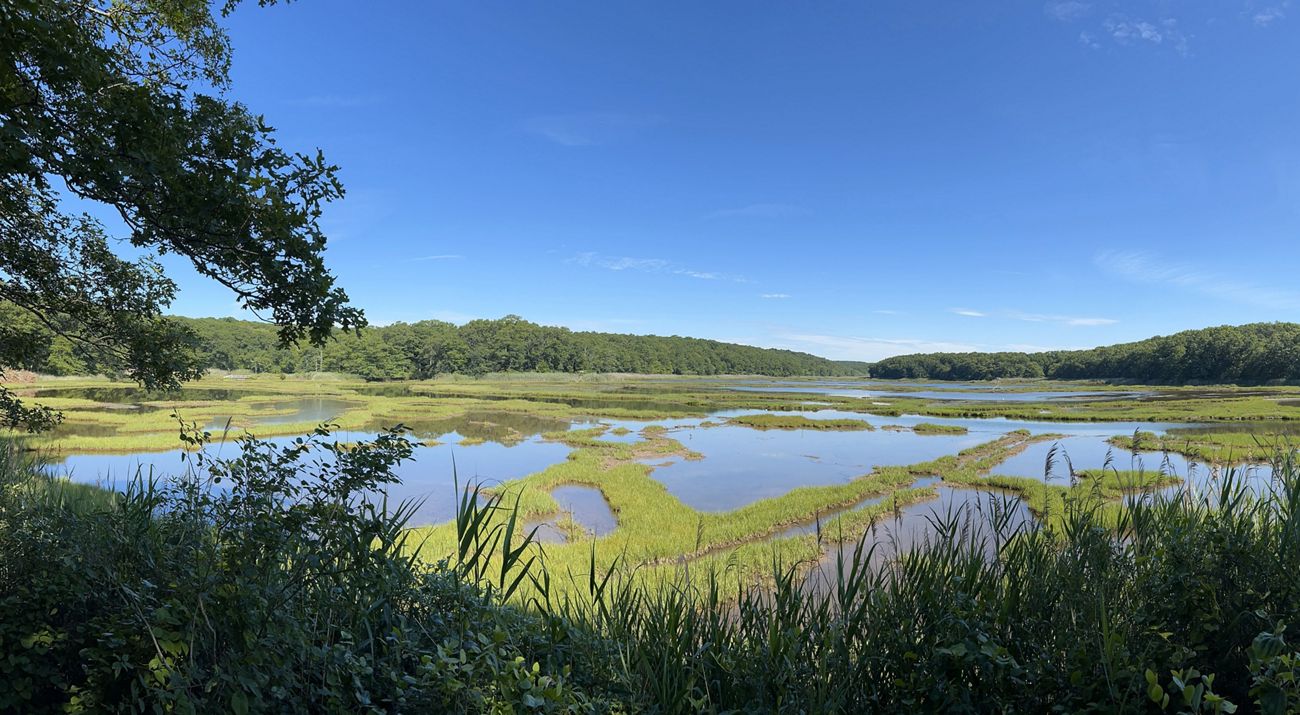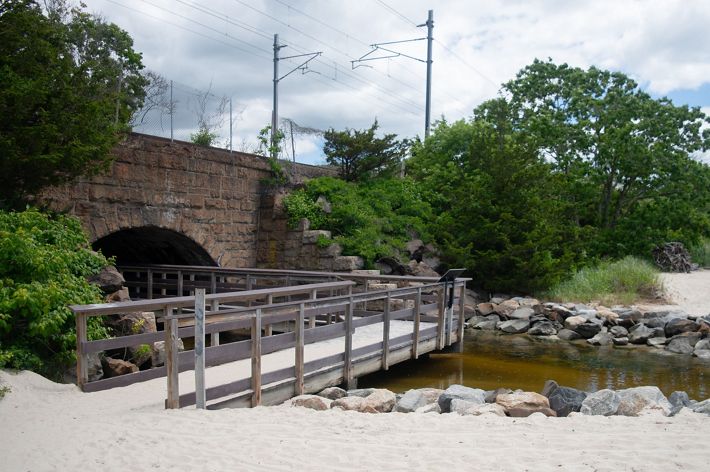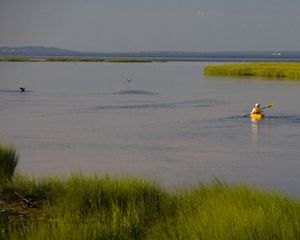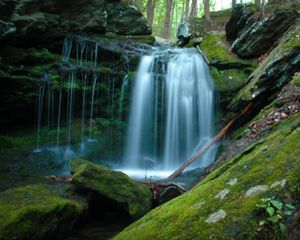The Nature Conservancy Secures Grant for Restoration Planning at Rocky Neck State Park
The $4 million grant supports planning for ecosystem restoration.

Media Contacts
-
Susan Wollschlager
The Nature Conservancy
Phone: 203-209-6218
Email: s.wollschlager@tnc.org
A $4 million grant secured by The Nature Conservancy will set in motion a planning process for transformative work to restore the Bride Brook estuary and coast marsh at Rocky Neck State Park in Connecticut. Funding has been awarded by the National Oceanic and Atmospheric Administration’s (NOAA) Transformational Habitat Restoration and Coastal Resilience Grant Program.
TNC will manage the “Bride Brook Estuary Transformation Project” in collaboration with the Connecticut Department of Energy and Environmental Protection (DEEP), which manages Rocky Neck State Park. The project will be implemented in partnership with NOAA, the Connecticut National Estuarine Research Reserve, Ducks Unlimited, Save the Sound and Restore America’s Estuaries.
The initiative will build upon previously completed projects at Rocky Neck State Park to ensure a healthy marsh, as well as ecosystem restoration and resilience, and improved visitor access to the park’s natural resources.
“We are incredibly excited to have secured these federal funds to restore an important ecosystem in Connecticut, and for the benefits that will extend to everyone who loves and lives near Rocky Neck State Park,” says Jessica Cañizares, TNC's coastal restoration project manager in Connecticut. “The funding needed for comprehensive, transformational restoration of the entire system has only become available recently under the Bipartisan Infrastructure Law and Inflation Reduction Act, and this was an ideal time to come together with the state and local partners.”
“The Connecticut Department of Energy and Environmental Protection is thrilled to be working with The Nature Conservancy and other partners on this important effort to improve marsh health and coastal access at Rocky Neck State Park,” says Katie Dykes, DEEP Commissioner for Environmental Conservation. “DEEP has been working to enhance coastal marsh habitat for species such as alewife, saltmarsh sparrow and a variety of waterfowl. With increased sea level rise and frequency and duration of storm events, there remains a need to look at the marsh ecosystem as a whole—beyond the boundaries of the State Park—and we are excited to collaborate with partners on expanding this essential process. DEEP is committed to providing high quality coastal access opportunities for the residents of our state and ensuring coastal habitats will be resilient to the effects of climate change, and this project addresses both priorities.”
Rocky Neck State Park is home to the Bride Brook tidal creek which flows into Long Island Sound, which boasts a tidal marsh, the largest alewife population in the state, a popular beach and boardwalk, a campground, wooded trails, a pavilion and an extremely popular fishing site. It’s also known for its position alongside an Amtrak route to the delight of many children who enjoy seeing trains pass during beach visits. The railway bridge was constructed in 1851, and Rocky Neck was established as a state park in 1931.
But the 82 acres of marsh at Rocky Neck have long faced challenges and are, in a sense, drowning, according to Cañizares. The marsh is a critical component of the ecosystem as it hosts unique biodiversity and provides protective benefits to coastal and inland communities.
“The marsh might seem healthy if you aren’t sure what to look for—it's green, there are osprey feeding, there are ducklings, we see fish and there are crabs. But this isn’t a healthy marsh. We see a lot of expanding open pools of water and mud, and there is a loss of vegetation. What we should see is the main creek channel of Bride Brook, bordered by a solid marsh platform, looking like a grassy meadow,” Cañizares explained.
"The restoration of the Bride Brook estuary and the marsh at Rocky Neck has consistently been among the highest priorities in the state, attracting the involvement of numerous groups for decades," says Tim Clark, TNC's southeastern Connecticut project director. “Their work has resulted in important conservation successes, specifically the culvert upgrade in 2009 that significantly improved fish passage for alewife, and beach enhancements.”
“However, bridges and other infrastructure along Bride Brook are likely contributing to a lack of full connectivity between the marsh and Long Island Sound. It’s believed these modifications altered the natural flow of water and disrupted how sediment moves through the system, leading to marsh degradation. This project will further study the issue, as well as determine and design solutions,” Clark explained.
Improving marsh conditions and restoring connections between Bride Brook and Long Island Sound would allow for large-scale, climate-resilient marsh restoration, strengthen the ecosystem and support fish passage. This work will benefit local communities as well. A restored marsh will act as a natural shield for the coastline, buffer effects of climate change, manage floodwaters, store “blue carbon”, and reduce ambient air and water temperatures. Alterations to existing infrastructure could also improve public access to and from the beach, while enhancing recreational and educational opportunities.
“We look forward to engaging with multiple communities in Connecticut to learn about how this project might improve the visitor experience at Rocky Neck, especially for all people of all abilities,” Clark added.
There are also economic impacts to consider: Re-establishing tidal connectivity at Bride Brook and restoring the marsh will enhance flood resilience at Rocky Neck and for surrounding communities by absorbing and dissipating floodwaters during storms. The Federal Emergency Management Agency (FEMA) estimates that tidal marsh habitats provide nearly $10,510 per acre per year in “ecosystem services,” including protective benefits. A fully functioning system at the state park would provide around $860,000 per year in benefits to wildlife, visitors and neighboring communities.
“Connecticut’s shoreline is enjoyed by countless people year-round and is a critical habitat for many species. We must continue to preserve and protect it. I am proud to see Bipartisan Infrastructure Law and Inflation Reduction Act dollars supporting this work in Connecticut, and I will continue to fight for these federal investments for our natural treasures,” says Senator Richard Blumenthal.
As co-chair of the bipartisan congressional Long Island Sound Caucus, Representative Joe Courtney said he was thrilled about the funding award and its role toward maintaining the area’s “vibrant natural heritage.”
“The grant awarded to The [Nature] Conservancy will support restoration of Rocky Neck State Park’s ecosystem, a habitat off of the Long Island Sound, and preserve the biodiversity of a unique coastal gem for years to come. This award is yet another example of the good work coming out of the federal Infrastructure Law and Inflation Reduction Act, which I helped enact. Congratulations to the coalition of conservationists throughout the state and district for obtaining this critical funding source,” Courtney added.
"NOAA is excited to be supporting The Nature Conservancy in Connecticut and partners as they work toward restoring healthy marsh habitat for the many species and communities that rely on this important coastal ecosystem," said Carrie Selberg Robinson, director of the NOAA Fisheries Office of Habitat Conservation.
Early work through the grant will focus on design, engagement with the local community and regulatory permits, setting the stage for restoration within and surrounding the marsh and Bride Brook. TNC will coordinate with DEEP to plan to conduct a robust public outreach effort to gather input from Connecticut residents and visitors to Rocky Neck visitors on desired outcomes from this restoration project.
This project will also have lasting impacts beyond this state park. TNC hopes to use this project as a vehicle to develop a roadmap for similar sites across Connecticut and New England, particularly sites facing concerns with tidal restrictions caused by transportation infrastructure, and with a need for resilient and equitable access to a public resource.
The Nature Conservancy is a global conservation organization dedicated to conserving the lands and waters on which all life depends. Guided by science, we create innovative, on-the-ground solutions to our world’s toughest challenges so that nature and people can thrive together. We are tackling climate change, conserving lands, waters and oceans at an unprecedented scale, providing food and water sustainably and helping make cities more resilient. The Nature Conservancy is working to make a lasting difference around the world in 83 countries and territories (39 by direct conservation impact and 44 through partners) through a collaborative approach that engages local communities, governments, the private sector, and other partners. To learn more, visit nature.org or follow @nature_press on X.




